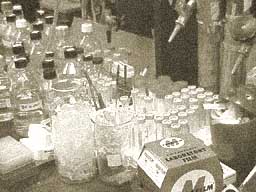|
|
 |
 |
Routine Culture of
wild-type Wangiella dermatitidis strain
8656 [ATCC 3410; Exophiala dermatitidis (CBS 527.6)]
|
Index:
(to jump to a listing, click on the desired name to the right) |
Materials
Protocol
Tips |
| |
Principle
and General Applications |
| |
|
| |
(Back to
the top) |
| |
Materials |
| |
|
| |
(Back to
the top) |
| |
Protocol |
| |
- Wangiella dermatitidis strain 8656 cannot use
nitrate or nitrite as nitrogen sources. Nitrogen is usually provided as ammonium ion or by
yeast extract.
- Wangiella requires 0.003 g/l thiamine (it can be provided by
the yeast extract).
- For historical reasons, Wangiella is often grown in MCB or a
modified Czapek Dox Yeast (CDY) broth (when not using Difco basal medium, refer to MCD
formula within the Genetic Transformation protocol) with 1
g/l yeast extract. These are semi-rich media that allow Wd to grow in all of its
varied morphologies.
- MCB culture medium is pH adjusted to 6.5 prior to sterilization.
The pH of freshly made medium is around 7.3, if deionized water is used.
Generally, we add the yeast extract after pH adjustment, but it works either way.
The yeast extract does not change the pH.
- MCB is distributed in 50-ml portions into Erlenmeyer flasks before
sterilization, which is for 15-20 minutes @ 121�C (15 psi).
- For innoculum size determinations, a hemocytometer is convenient for
determining yeast cell concentrations before an experiment. For accurate and
reproducible results, place a loopful of diluted culture on the hemocytometer and then
gently drop the cover slip on. Do not squirt cells under the cover slip with a
pipette. Use adequate dilution to insure there are no more than several hundred
cells in the counting field. A dilution of about 1/20 or 1/50 is sufficient for a
24-hour-old culture, assuming the initial inoculum level was one million cell units per
ml. For older cultures, dilutions of 1/100 or 1/200 are common. A cell unit
is considered any number of connected cells (usually one, two, or three) and is equivalent
to a colony forming unit (CFU). These can also be called microcolonies. It is
a good idea to include a drop of Tween 20 in the diluted sample before counting.
This helps disperse cells that are stuck together but not actually attached.
- If one starts with a million (10
6 CFU) units per ml, the culture will be in early-to-mid log phase of
growth after 12 hours and mid-to-late log phase after 24 hours and will be in stationary
phase after 48 - 72 hours. The usual preparation for an experiment involves two
48-hour passages and two 24-hour passages before collecting inoculum. A passage is
accomplished by pipetting 1 ml of a dense culture into a fresh 100-ml flask of broth.
- Cells may be collected for experiments by centrifuging an appropriate
volume of culture (based on hemocytometer counts) at 1700 x G for 5-10 minutes (or 1
minute in a microfuge operating at 14,000 RPM). After draining the supernatant, the
cells can then be resuspended in a known volume.
|
| |
(Back to
the top) |
| |
Tips |
| |
- Numerous other media
have been used for the experimental culture of W. dermatitidis, depending on the
experiments involved, including YPD, SD, and CDN. For the compositions of these
media please refer to other protocols listed as well as publications about W.
dermatitidis at this site.
106 CFU correlates with an O.D. of
approximately 0.5. 107 CFU [approximately mid-log (36 hours)] correlates
with approximately an O.D. of 0.8.
|
| |
(Back to
the top) |
 |
This page updated on:
Monday, March 03, 2003 11:09:48 PM |
|
|
|
|